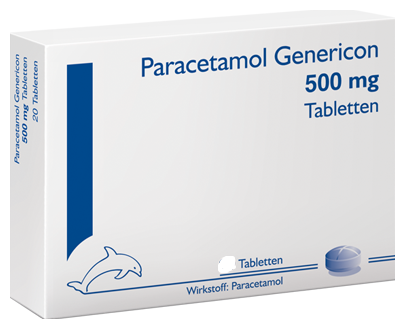Genericon Pharma
Paracetamol Genericon 500 mg 60 tablets
Paracetamol Genericon 500 mg 60 tablets
Couldn't load pickup availability
Paracetamol Genericon contains the painkilling and fever-reducing active ingredient paracetamol.
Paracetamol Genericon is used for:
- mild to moderate pain (such as headaches, toothaches, period pains)
- Fever and pain with colds and flu-like infections
If you don't feel better or feel worse after 3 days, contact your doctor.
Contraindications
Paracetamol Genericon must not be taken
- if you are allergic to paracetamol or any of the other ingredients of this medicine (listed in section 6).
- if you suffer from severe impairment of liver function.
- if you suffer from a certain hereditary metabolic disorder (glucose-6-phosphate dehydrogenase deficiency).
- if you are a chronic alcoholic.
- by children under 6 years of age (see section 3 “How to take Paracetamol 500 mg tablets?”)
Interactions
Taking Paracetamol Genericon together with other medicines
Tell your doctor or pharmacist if you are taking/using any other medicines, have recently taken/used any other medicines or might take/use any other medicines.
Combination of paracetamol (the active ingredient in Paracetamol Genericon): Possible interactions
-
Medicines that, due to their properties, have an influence on the liver, such as anti-tuberculosis drugs (rifampicin) or anti-epileptic drugs
- Liver damage
-
anticoagulants (“anticoagulants”) such as warfarin or fluindione
- The anticoagulant effect can be increased with prolonged use (more than a week).
-
certain medications for pain and fever (salicylamide)
- delayed excretion of paracetamol
-
certain medicine for gout (probenecid)
- The breakdown of paracetamol may be slowed; The dose of paracetamol should therefore be reduced.
-
certain antibiotic = medicine against infections (chloramphenicol)
- The degradation of the antibiotic may be delayed (increased side effects possible).
-
certain medicines for HIV infection (zidovudine)
- The tendency to reduced production of white blood cells (neutropenia) is increased. Paracetamol Genericon should therefore only be taken at the same time as zidovudine on medical advice.
-
certain medicine for gastrointestinal ulcers (nizatidine)
- increased blood levels of paracetamol in the body
-
certain medicines for gastrointestinal problems (cisapride)
- increases the availability of paracetamol in the body
-
certain medicines for epilepsy or depression (lamotrigine)
- decreased the availability of lamotrigine
-
Medicines to delay gastric emptying (e.g. propantheline)
- The absorption and onset of action of paracetamol can be delayed
-
Medicines that accelerate gastric emptying (e.g. metoclopramide)
- The absorption and onset of action of paracetamol can be accelerated
-
certain drug to lower high blood lipid levels (cholestyramine)
- Absorption and effectiveness of paracetamol may be reduced
-
alcohol
- Liver damage (see section 2 “What should you consider before taking Paracetamol Genericon?”)
Effects on laboratory tests
Taking Paracetamol Genericon can affect laboratory tests such as uric acid testing and blood sugar testing.
Taking Paracetamol Genericon with food, drinks and alcohol
You must not drink alcohol while taking Paracetamol Genericon.
Taking it after meals may result in a delayed onset of action.
Pregnancy and breast-feeding
If you are pregnant or breast-feeding, think you may be pregnant or are planning to have a baby, ask your doctor or pharmacist for advice before taking this medicine.
Pregnancy:
If necessary, Paracetamol Genericon can only be taken during pregnancy after careful consideration of the benefit-risk ratio. Your doctor will therefore decide whether to use it during pregnancy.
Do not take Paracetamol Genericon during pregnancy for a longer period of time, in higher doses or in combination with other medicines, as the safety of its use in these cases has not been proven.
Breastfeeding:
Paracetamol passes into breast milk. Since there are no known adverse consequences for the infant, interrupting breastfeeding is usually not necessary.
However, the dosage should be as low as possible and the duration of use should be kept as short as possible.
Application
Always take this medicine exactly as described in this leaflet or exactly as your doctor or pharmacist has told you. Check with your doctor or pharmacist if you are unsure.
Dosage
In principle, painkillers should be dosed as low as is necessary for a sufficient effect in order to keep the risk of undesirable effects occurring as low as possible.
The time interval between two doses should be at least 6 hours.
Unless otherwise prescribed by the doctor, the usual dose is:
Adults and adolescents aged 12 and over (and at least 43 kg body weight):
1 tablet up to a maximum of 4 times a day.
The maximum daily dose of 4 tablets (corresponding to 2000 mg paracetamol) must not be exceeded.
Children from the age of 6 to the age of 12:
½ tablet up to 3 times a day.
Children under 6 years
Paracetamol Genericon is not suitable for children under 6 years. Other suitable dosage forms with a lower active ingredient content are available for them.
Please seek advice from your doctor or pharmacist in this regard.
Elderly patients (65 years and older)
No special dosage adjustment is required based on age. If you are underweight or have organ dysfunction, please follow the relevant instructions.
Patients with liver dysfunction
In patients with liver dysfunction and Gilbert's syndrome (a congenital disease), the dose must be reduced or the dose interval (= the time between two doses) must be extended.
Patients with kidney dysfunction
If there is severe kidney dysfunction, a dose interval (= the time between 2 doses) of at least 8 hours must be maintained.
Method and duration of
use Oral use.
The tablet can be divided into equal doses.
Take the tablets with sufficient liquid (preferably a glass of drinking water).
Limit the duration of use to the duration of the illness.
If symptoms persist for more than 3 days, see a doctor.
Side effects
Like all medicines, this medicine can cause side effects, although not everyone gets them.
At the first signs of a hypersensitivity reaction (e.g. difficulty breathing, skin reaction),
Paracetamol Genericon must not be taken again and a doctor should be consulted immediately.
The following side effects may occur:
Rare side effects (may affect up to 1 in 1,000 people):
- Increase in certain liver values
Very rare side effects (may affect up to 1 in 10,000 people):
- Changes in the blood count (reduction in all blood cells, reduction in the number of blood platelets, or severe reduction in certain white blood cells), certain disorders of the red blood pigment (methemoglobinemia), asthma-like narrowing of the airways in sensitive people, hypersensitivity reactions ranging from simple skin redness or urticaria (hives). for shock reaction with circulatory failure, serious inflammatory skin reactions with blistering such as acute generalized exanthematous pustulosis (AGEP), erythema exsudativum multiforme (Stevens-Johnson syndrome) and toxic epidermal necrolysis (Lyell syndrome)
Side effects with unknown frequency (frequency
cannot be estimated from the available data):
- Liver damage, skin rash
composition
The active ingredient is: paracetamol.
Each tablet contains 500 mg paracetamol.
The other ingredients are: polyvinylpyrrolidone, colloidal silicon dioxide, magnesium stearate, carboxymethyl starch sodium.
Usually ships out within 3-4 business days
Share


